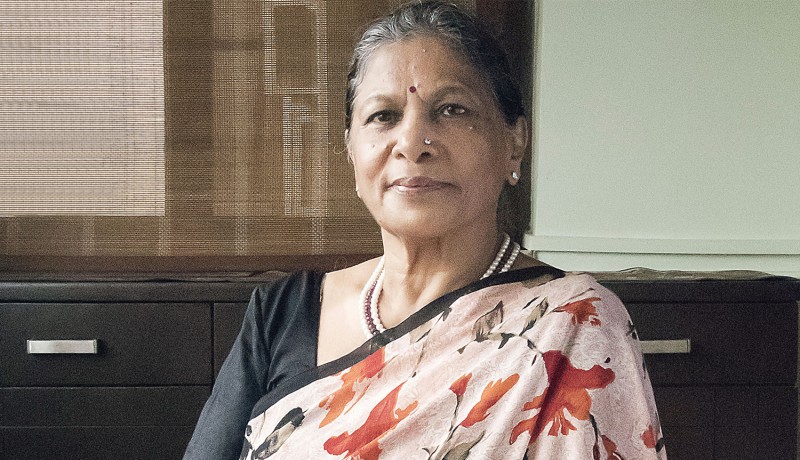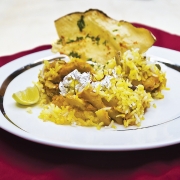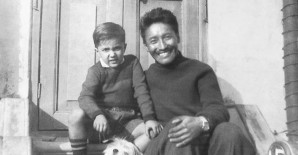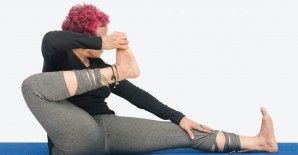
Columns

A series by Pratibha Jain about silvers who believe nurturing the body and mind is the key to joy.
Featuring Sudha Nahata from Mumbai
Whether it is special vegetables like chakki ka saag and pachkuta or rice dishes like kabuli pulao, she grew up seeing her mother and grandmother mix the masalas themselves even though the kitchen was the cook’s domain. Indeed, 71 year-old Sudha Nahata, a Rajasthani from Mumbai, believes it is all about mixing the masalas right: the right ingredients in the right proportion! And how does one arrive at this perfect taste? “I would love to share my recipes with you, but honestly I don’t know the exact measures,” she responded with a smile. Like many of our elders whose expertise in the kitchen has nothing to do with teaspoon and cup measurements, Sudhaji has that uncanny andaaz while cooking. As she shared the famous Jodhpuri recipe of kabuli with me, I could see her fingers dance as though they were actually mixing the ingredients.
Draped in an ethereal peach chiffon sari glistening with zardozi, Sudhaji was a picture of regal elegance. I met her on her recent visit to a wedding in Chennai and we chatted late into the night about several things: food, family, work and the art of harmonising everything. It was easy to see how much she is loved and cherished by family and friends as some of her relatives participated in our conversation. Naveen Galada, who had introduced us, said, “She is always high on life and blessed with a rare combination of practicality and a futuristic vision. Whenever I see her, I wish she would start a grooming school for young girls.” Prathna Sawansukha summed it up well, “Whether it is family, friends or her customers, she is admired by one and all. She binds us all together. Her house has always been a home where we felt loved and welcome.” Here are some titbits of our conversation.
IN HER OWN WORDS
I grew up in Jaipur. Despite a strict upbringing, we were encouraged to learn many skills like swimming and horse riding. To date, MGD [Maharani Gayatri Devi] Girls School remains one of the best in Rajasthan, and we were lucky to have studied there. Thanks to my father’s vision, my sister was the first non-Rajput girl to study there. I would have loved to pursue my studies, but I was married to Navratanmalji Nahata when I turned 15. We shifted to Mumbai in 1966. I have lived there since.
FAMILY PRIDE
I have been blessed with four daughters and six grandchildren. I lost my husband in 2012 and now my granddaughter lives with me. I can proudly claim that we have given a good upbringing to our children. It pleases me to see how each one of them has adjusted to their respective families.
VALUES – THEN AND NOW
As we were the only ones from our families living in Mumbai, we often had relatives, nieces and nephews visiting and staying with us. Many of them lived with us for extended periods while they pursued their higher studies. We treated them all as our own children or family, and they gladly adapted to our lifestyle. It is different these days. Now, parents provide their children with everything and they do not want their children to ever compromise. I am not saying it is good or bad—just different.
WORKING FROM HOME
I started a small unit for children’s clothes in 1975. Relatives and friends started depending on me for their kid’s clothes. I enjoyed the entire process, from procuring the fabric, laces and buttons to creating the design. Backed by a good tailor, I managed quite easily. Seeing how well I coped with orders, my husband encouraged me to start a commercial venture. I held my first exhibition in September 1975. My collection sold very well, I was inundated with orders, and my company ‘Pixies’ was born. It did very well but I slowed down a bit since 1996 owing to health reasons. I have always preferred working from home even though people advised me to start a boutique. Somehow I always felt I could do justice to my husband and children if I worked from home.
CULINARY INSPIRATION
All through my growing years, we always had cooks in our kitchen. My grandmother was particular about our clothes being neat, well-ironed and clean; hence, she never encouraged us to potter around in the kitchen. So I really don’t know how and where I learnt to cook! I remember the first time I cooked a full meal. It was after about a month of marriage; the cook was absent one day and my mother-in-law was not in town. Consequently, my grandmother-in-law looked worried about who would prepare the day’s food. I told her that if she guided me, I would cook. I cooked that day and she was absolutely delighted! Mind you, she was not easy to please. She not only loved my cooking but also praised me. I was all of 15 and had a ghunghat covering my face. But, yes, I was confident and not at all nervous. I am grateful to my mother who instilled this quality in me.
MANAGING PEOPLE
Our staff remains the same, for over 40 years. We have had the same cook and I have used the services of the same tailor for years. Friends often ask me what makes this possible. I think it is one’s behaviour and capacity for a healthy rapport that makes a real difference. If one can learn to respect the needs of others, it becomes easy to get along with others.
FOOD HABITS
Earlier we ate rich food at home, but now we don’t eat much fried or spicy food. Recipes have been tweaked over the years. When the children were young, every Sunday was a treat: we eat restaurant style. I have always enjoyed making special dishes and we also enjoy eating out once a week. My own favourites include Mumbai street food: bhelpuri, vada pav, dabeli…. I do not diet but I am diet-conscious. For instance, my husband always had daliya [porridge with broken wheat] for breakfast. He was extremely dietconscious. I did not care much for daliya, so I would eat fruits instead.
SOME FAVOURITE SPICES
At home, I always have some special masalas. For instance, the jirawan of Malwa [Indore] is really handy. Sprinkle it over poha or add a dash of it to a simple salad. Serve it with khakra brushed with ghee or apply it over leftover rotis and puris and enjoy as a roll. A must while travelling. Next on my list is kathbel ka pachak from Murshidabad. I get it from Kolkata. Just sprinkle it over mathri or khari biscuits and enjoy the difference. And then there is the dal ka masala from Agra. If your dal or sabzis are tasting a bit bland, simply add this masala. It also gives a punch to samosas.
LEFTOVER TIPS
A favourite at home is toasty toast with leftover pav bhaji. Cook the bhaji until it thickens. Sandwich it between two bread slices and bake it in the toaster oven. You can do the same with leftover potato or paneer sabzi.
MANTRA FOR SUCCESS
The simple mantra for success is your smile! Your smiling face can make you a winner. I have always told my daughters that with their smile and attitude, they should leave a lasting impression wherever they go.
HEALTHY KABULI PULAV
(Layered rice and vegetables)
A famous and rich rice dish from Jodhpur, this is a favourite at celebrations and weddings. It is highly possible that this dish is the vegetarian version of Qabili Pulav, the national dish of Kabul. Though the original recipe requires the vegetables and bread slices to be deep-fried in ghee, Sudhaji has tweaked the recipe into a healthier one.
Ingredients
For the rice
- Rice: 2 cups (300 gm)
- Lemon juice: From 2 large lemons
- Cardamom powder: a generous pinch
For the vegetables
- Potatoes: 500 gm; sliced thickly
- Purple yam (ratalu): 300 gm; sliced thickly
- Cauliflower: 300 gm; chopped into florets
- Onions: 500 gm; sliced thickly
- Fresh peas: 1 cup; shelled
For the masala
- Onions: 300 gm; chopped roughly
- Garlic: 125 gm (about 2 pods)
- Chilli powder: 2½ tbsp
- Coriander powder: 2½ tbsp
- Turmeric powder: ¼ tsp
For the whole garam masala
- Peppercorns: 5
- Cinnamon: 1-inch stick
- Cloves: 5-7
- Bay leaves: 3-5
Other ingredients
- Bread: 3 slices
- Asafoetida powder: a generous pinch
- Saffron: a few strands
- Milk: 1½ cups; boiled
- Yoghurt: 2-3 tbsp; beaten
- Ghee: 1 to 1½ cups
- Salt to taste
Method
Cook the rice along with ½ tsp of salt. Take care not to overcook it; allow each grain to remain separate. Cool it by spreading on a large shallow plate. Gently mix the lemon juice and cardamom powder into the cooled rice. Steam the chopped vegetables (potatoes, yam, cauliflower, onions and peas) by placing them in separate containers in a dhokla maker. Take care not to overcook. Now bake the potatoes, yam and cauliflower for 5 minutes on 150ºF. (Traditionally, all these, except the peas, were deep-fried in ghee.) Grind the ingredients for the masala (onions, garlic, chilli powder, coriander powder and turmeric) into a fine paste. Soak the saffron in 1 tbsp of warm milk. Rub it until the milk turns orange. Mix it into the remaining milk. Toast the bread slices and quarter them. Heat 1 cup of ghee in a large pan. Add the asafoetida powder and the whole garam masala. As the aroma rises, add the ground masala and sauté for 8-10 minutes until the ghee separates. Now, add the yoghurt and cook for 4-5 minutes. Add 2 cups of water and bring to boil. Now, add the vegetables: first the yam and peas, then the potatoes, and finally the cauliflower and onions. Switch off the flame and add the toasted bread pieces. In a baking dish, spread one layer of the rice preparation at the bottom. Top it with a layer of the vegetable preparation. Top with another layer of the rice preparation. Repeat the layers if the dish is tall enough. Using the end of a spoon, make 4-6 holes in the arranged pulav dish. Sprinkle the saffron milk on the sides of the dish and pour it into the holes. Cover the pulav with an aluminium foil and bake for 10-15 minutes on 200º F. Serve hot.
Pratibha Jain, an author and translator from Chennai, is the co-author of two award-winning books Cooking at Home with Pedatha and Sukham Ayu.
Her area of specialisation is documenting Indian traditions through research, translation and writing
Photos: Haresh Patel Featured in Harmony — Celebrate Age Magazine July 2017
you may also like to read
-
Mental workout
Mukul Sharma tells you how to keep those grey cells ticking Everyone will ultimately lose his or her brain….
-
Helpline
Dr Harshbir Rana answers your queries on personal and social issues related to ageing, elder care and intergenerational relationships ….
-
Off the cuff
Raju Mukherji pays tribute to his first hero, Tenzing Norgay, an exemplary mountaineer Darjeeling, 1955. Dr ‘Pahari’ Guha Mazumdar….
-
Yoga RX
Shameem Akthar shows ways to control debilitating ankle pain through regular practice Ankle pain is so common and prevalent….








